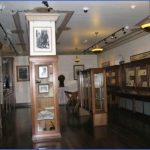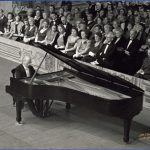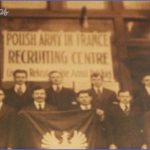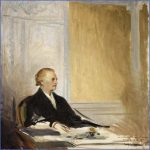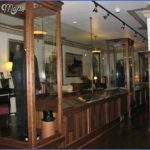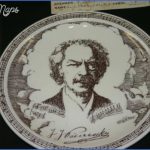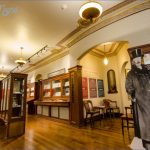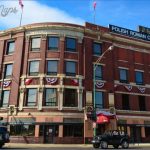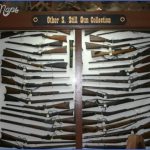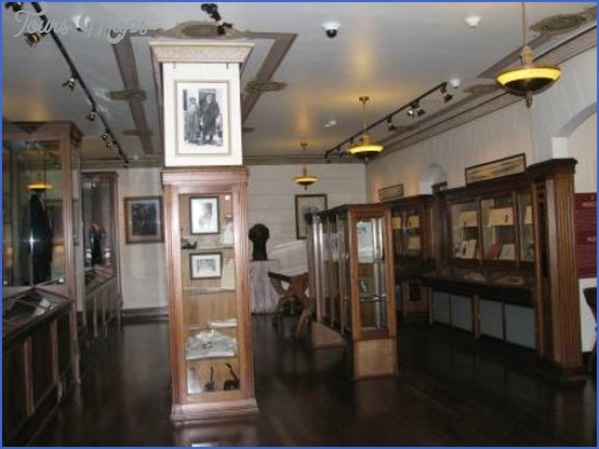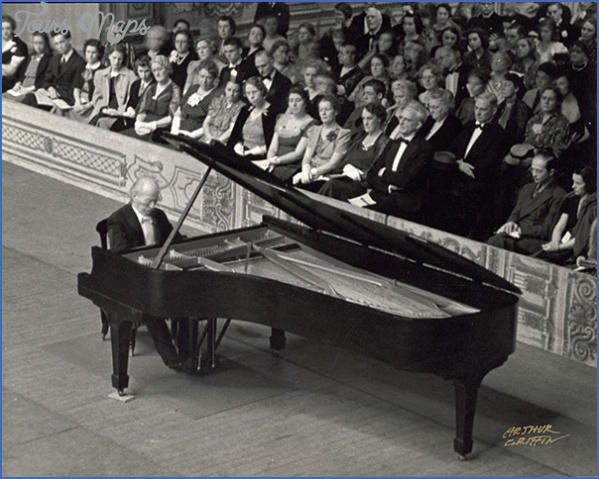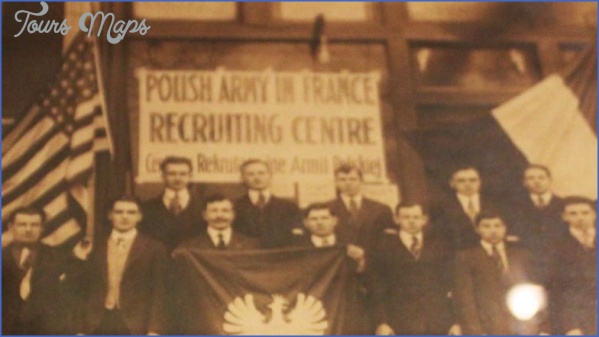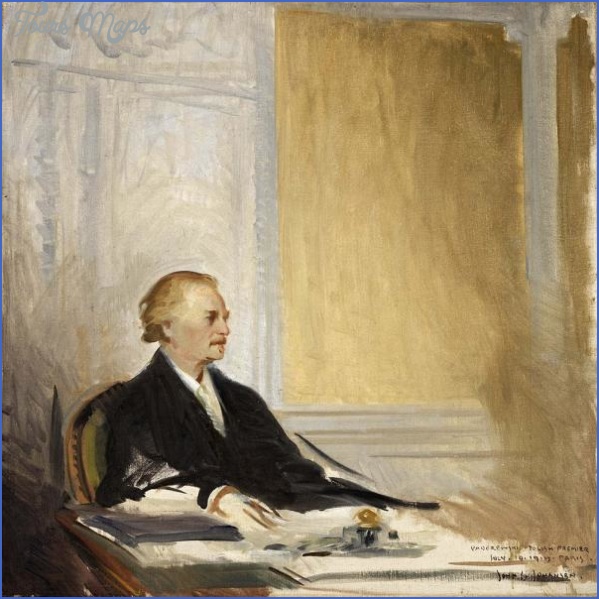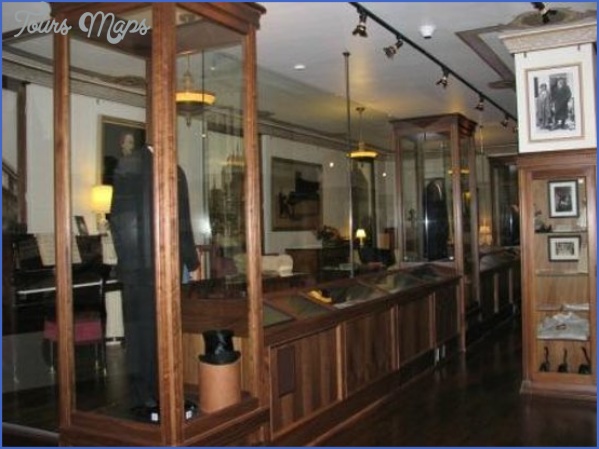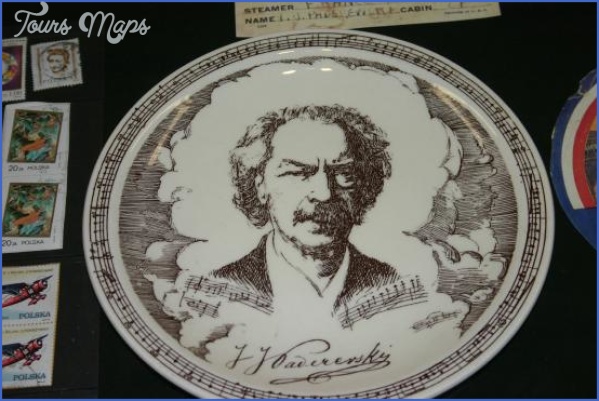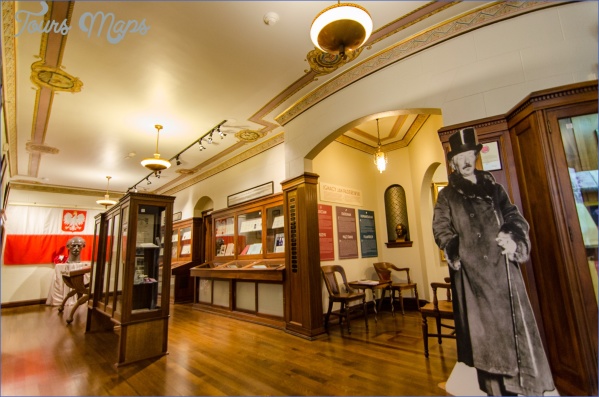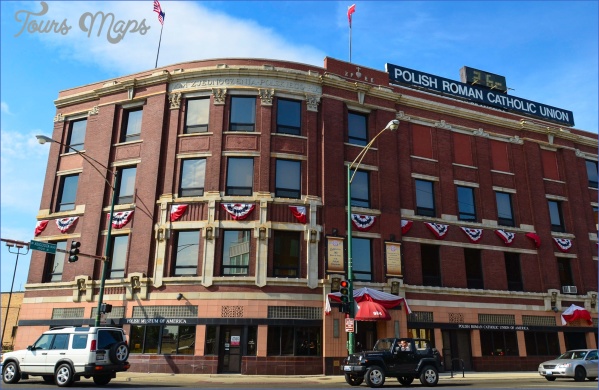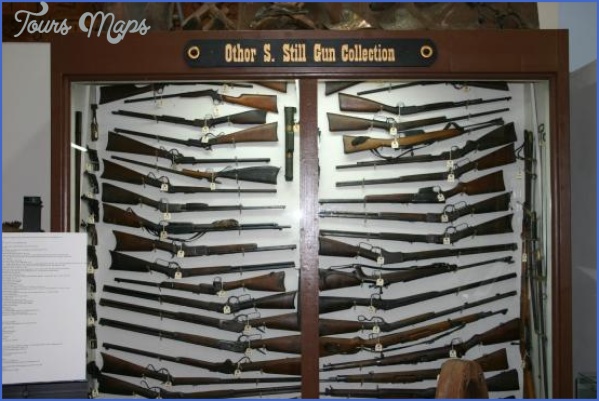PADEREWSKI MUSEUM
Not many musicians become prime ministers. Ignacy Jan Paderewski, born in Kurylowka, in Podolia (now in Ukraine), in 1860, used his international standing as pianist and composer to further his country’s causes and espe- cially Polish independence; and after World War I it was he who represented Poland at the signing of the Treaty of Versailles. He served as Prime Minister and Minister for Foreign Affairs from 1919 until 1922, when he returned to composition, concert-giving and teaching. At the beginning of World War II he again campaigned for his country, in the USA, but he died in New York in 1941. His remains were returned to Poland in 1992.
Naturally enough, he is commemorated rather grandly in Warsaw, in a special museum occupying the north side of the palatial Podchorazowky house, set in parkland (the Zazienki Park) near the centre of the city. Called the Museum of Ignacy Jan Paderewski and Polish Emigration in America, and opened in 1992, it is a branch of the National Museum.
It has three main rooms concerned with Paderewski as a musician. The first, modelled on the salon at Riond-Bosson, Paderewski’s house in Switzerland, is a large double salon, with his own furniture (a sofa, his desk, his silver tea service, his 1929 Erard boudoir grand with signed photographs from Queen Victoria, Saint-Saens and others). There are several silver wreaths and two portraits of the man himself, the famous one by Alma-Tadema and one by Charles Giron, with Giron’s painting of Helena, Paderewski’s (second) wife. This leads into the recital hall, a handsome room seating about 150, with Paderewski’s Steinway and another piano, several
PADEREWSKI MUSEUM Photo Gallery
The Paderewski museum, Warsaw portraits of his musician friends and a white marble bust of 1901 by Edward Onslow Ford. The late portrait by Tadeusz Styka (1937) is in the corridor, along with various honours accorded to Paderewski from other countries. The third room records his activities as a concert pianist – shields, medallions, diplomas and above all laurel wreaths, of which there are ten, a display of vases (chiefly gifts from American institutions) and several fine ornamental batons (in ebony, ivory, mother-of-pearl and silver) as well as photographs, busts of Beethoven and of Paderewski, and his mute practice keyboard and his violin. The museum archives house various documents concerning Paderewski and America, including his correspondence with Presidents Wilson and Roosevelt (other documents and his library are at the Jagiellonian University, Krakow). In a further, adjoining group of rooms his art collection, particularly rich in Chinese and Japanese items (more than 300), is displayed. Not many musicians could be so lavishly commemorated, but then few achieved Paderewski’s distinction in a wider world. In 1897, Paderewski bought a country estate in southern Poland at Kasna Dolna, south of Tarnow and just to the west of the small town of Ciazkowice. He modernized the mansion and improved the surrounding parkland, but stayed there only briefly and sold it in 1903. The mansion passed through various hands, was split up under socialist rule and became first a school and then an agricultural college. But in 1983 it was taken over by the Tarnow Musical Society, who used it for concerts, set up a museum and oversaw the house’s restoration and partial rebuilding. In 1990 a Tarnow-Kasna Dolna Paderewski Centre was set up to manage the estate and there was further renovation at the end of the 1990s. The handsome, single-storey mansion serves as a museum to Paderewski as well as a centre for concerts, workshops, competitions, courses and conferences. In the large drawing-room across the front of the building are his own Petrov piano, much of his furniture (a table and, re-covered, chairs and a sofa), portraits and family photos, a statuette, a fine needlepoint imperial eagle (the work of his second wife, Helena) and the portable loo with which he always travelled. In an alcove are several of his own cabinets with books from his library; there are also concert programmes and commemorative postcards. In the adjoining recital room, L-shaped, which seats over 70, is a fine Fazioli grand piano, with some recent portraits and photos of musicians who have visited Kasna Dolna. Two rooms at the rear of the building carry changing exhibitions of works of art loaned from museums in Warsaw. What was formerly the housekeeper’s residence, adjoining, is now a small hotel for visitors used in particular for entrants to the annual piano competition. For over 40 years Paderewski’s home was in Morges, a charming old town on the north side of Lac Leman (Lake Geneva), some 50 km from Geneva and ten from Lausanne; Morges was also Stravinsky’s home from 1916 to 1920. In 1897 he rented, and two years later bought, a spacious, chalet-like lakeside villa, Riond-Bosson, in a splendid park just outside Morges; it was to have been a refuge where he could devote himself to composition and to rest after arduous concert seasons, but it also became a meeting-place for musicians and political figures from various parts of the world. The house was demolished in 1965, but in 1991 the local Societe Paderewski, founded in 1977, established a Musee Paderewski, situated in the town’s Centre Culturel, close to the Casino and the lake. Although modest in size, it holds a rich collection of letters and documents, over a thousand photographs, many concert programmes, copies of the scores of nearly all his compositions and literature on the composer as well as personal objects such as his wedding ring, his fountain pen, his famous piano stool and one of his dress suits, as well as furniture. Many of the objects were presented to the museum by local people who remembered Paderewski. The display is neatly organized, in a single, large room. Paderewski is also commemorated in Morges with a statue in the Parc de la Maison de Seigneux, a Promenade Paderewski and an Avenue Paderewski; there is a Boulevard Paderewski at Vevey and another at Lausanne, where he gave several recitals, and a bronze plaque in the Salle Paderewski at the Casino de Montbenon.
Paderewski is commemorated too in California, where since 1993 there has been an annual Paderewski Festival at the ranch he owned in Paso Robles, Rancho San Ignacio (where he grew almonds, walnuts and prunes and had a Zinfandel vineyard); the Pioneer Area Museum there has a Paderewski Room, endowed by his descendants.
Maybe You Like Them Too
- Explore Doncaster, United Kingdom with this detailed map
- Explore Arroyito, Argentina with this Detailed Map
- Explore Belin, Romania with this detailed map
- Explore Almudévar, Spain with this detailed map
- Explore Aguarón, Spain with this detailed map

